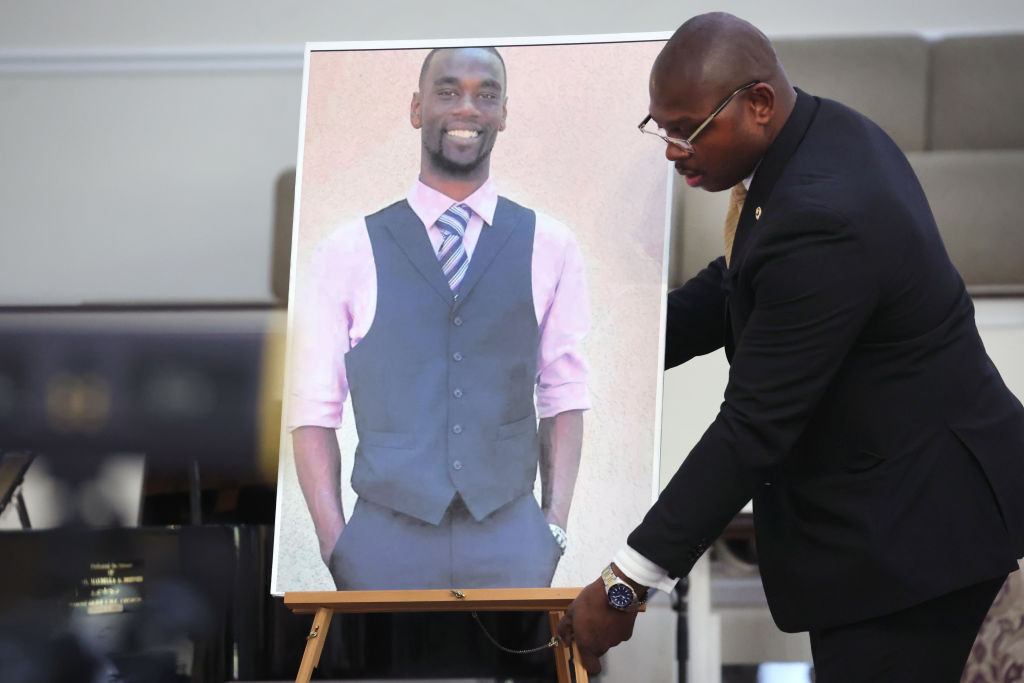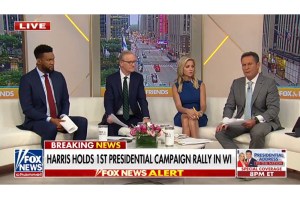Racism has become an unfalsifiable proposition. Such is the central take-away from the race industry’s tortured reaction to a brutal police beating in Memphis, Tennessee.
Five Memphis officers responded to what was initially reported as a car driving the wrong way down a street. The officers’ tactics during the stop of driver Tyre Nichols, captured on video, were an abomination: while shouting contradictory commands, the officers immediately escalated their use of force without apparent cause.
It was Nichols who tried to deescalate the chaos — a responsibility usually put on officers, not on suspects. The cops struggled without coordination to cuff him, while delivering gratuitous kicks, punches to the face and baton strikes. None of the officers’ actions conform to police training; virtually everything on view in the videos violates sound stop and arrest techniques. Nichols repeatedly collapsed and received only belated and listless medical attention at the scene. Three days later he died in hospital.
Whether Nichols was high — one of the officers during the interaction says that he was — and whether that drug use contributed to his death is not currently known. The official autopsy has yet to be released; the autopsy commissioned by Nichols’s family attributes his death to the beating.
Initial news stories modified the usual mainstream media procedure for reporting on police use of force against black suspects. Yes, the stories immediately announced Nichols’s race. But they deferred mention of the officers’ race until five or six paragraphs into the article (or, in the case of television, several minutes into the transmission).
Had the officers been white, their race would have led every report on the incident. But since all were black, such reticence bought time until a new racism reporting protocol could be developed.
CNN commentator and Obama White House veteran Van Jones initiated that new protocol. Connoisseurs of academic identity politics are familiar with the nostrum that only whites can be racist, since, according to black studies ideology, racism equals power plus privilege (and blacks allegedly lack both).
But that “blacks can’t be racist” line has changed. Now we learn from Van Jones that blacks can be racist, too — at least as regards other blacks.
“It’s time to move to a more nuanced discussion of the way police violence endangers black lives,” Jones wrote on the CNN website last Friday. “It is the race of the victim who is brutalized, not the race of the violent cop — that is most relevant in determining whether racial bias is a factor in police violence.”
In other words: anything bad that happens to blacks is a function of racism, determined solely by the race of the victim, not by the intentions or identity of the perpetrator.
Only cops are subject to this new “the victim alone determines the reality of racism” rule, however. Those black teenagers who shoot at their gang rivals on a near daily basis and who regularly take out young black children as collateral damage are not deemed “anti-black” by the mainstream media and its academic sources.
The rest of the race industry quickly coalesced around Jones’s lopsided definition of racism, from which whiteness has been provisionally suspended (to be restored the next time a white cop is caught on videotape using force against a black suspect).
It’s the blue uniform that makes a cop racist, not the color of his skin, a University of Southern California law professor told the New York Times.
A race activist working with the Nichols family echoed that sentiment. Racism is a clear factor in policing when you look at the victims of police violence rather than officer race, Amber Sherman insisted.
More bravura sightings of racism followed. Initially, the media and politicians had celebrated the rapidity with which the five officers in the Nichols beating case were charged with murder, attributing the lack of riots to those indictments. (The likelier reason for the relative calm is the officers’ race. An itinerant protester told the Washington Post that had the officers had been white, “all hell would have broken loose. The city would have been in war.”)
But now it turns out that that immediate response from the justice system is just another manifestation of racism. Benjamin Crump, the ubiquitous civil rights attorney now representing the Nichols family, complained that “we have never seen swift justice like this” when white officers are involved. An activist also working with the Nichols family groused that by quickly firing and indicting the officers, the “city and the police department reminded them that they are black men, and they will treat them less than, just like they treated Tyre.” An employee with the left-wing Center for Policing Equity rued that sending the officers to prison would add to the number of incarcerated blacks.
At this point, even the most docile “ally” should be despairing of ever getting things right.
Meanwhile, President Joe Biden has been sounding evergreen themes regarding criminal justice racism. The beating was “yet another painful reminder of the profound fear and trauma, the pain, and the exhaustion that black and brown Americans experience every single day,” Biden said in a statement after the video release. President Barack Obama first promoted this “daily pain and trauma” idea; Biden made it a regular refrain during his presidential campaign and once in office.
The conceit would be true if it referred to black-on-black crime. Dozens of blacks are murdered every day, more than all white and Hispanic murder victims combined, even though blacks are only 13 percent of the nation’s population. Blacks between the ages of ten and twenty-four die of gun homicides at twenty-five times the rate of whites between those same ages. Their assailants are not the police, not other whites, but other blacks.
Ending all fatal police shootings — a desirable goal, but an unlikely one, given the amount of gun violence in America’s inner cities — would have a negligible effect on the black death by homicide rate. In fact, it would have a greater effect on the white death by homicide rate, since it turns out, contrary to the racism narrative, that the proportion of white and Hispanic homicide victims killed by police officers is over four times higher than the proportion of black homicide victims killed by a police officer: 9 percent versus 2 percent.
That disparity exists because the number of black homicide victims — killed almost exclusively by black criminals, not by the police or by whites — is so high. In 2020, there were about 10,000 black homicide victims, 3,000 more than all white and Hispanic homicide victims combined. By comparison, there are about 1,000 victims of fatal police shootings each year, a little over 50 percent white, on average, and about 25 percent are black.
Even though white and Hispanic homicide victims are more likely than black homicide victims to be killed by a cop, racial demagogues still claim that police shooting data show police bias. They invoke the fact that judged against population ratios, black civilians are two to two and a half times more likely to be killed by a cop than white civilians are.
But the population benchmark, the only one ever used by the media and anti-cop activists, is irrelevant for policing. Police deployment and tactics are determined by the incidence of crime, not by census data. An officer’s use of force, including potentially lethal force, will depend on the frequency with which he confronts armed, violent and resisting suspects. Such confrontations, given the black crime rate, occur disproportionately in black communities.
The Bureau of Justice Statistics reports that blacks commit about 60 percent of murders and robberies in the seventy-five largest US counties, which is where most of the population resides, even though they are only 15 percent of the population in those counties.
With crime as the benchmark for police activity, the 2.5 ratio of black to white victims of police shootings flips. It is whites who are 2.5 times as likely to be fatally shot by a police officer as blacks, according to Michigan State University researcher James Cesario. This finding of no anti-black bias in police shootings has been replicated numerous times, both through empirical analyses of data and through “shoot-don’t shoot” exercises on shooting simulators.
As for police shootings of allegedly unarmed blacks, such deaths are an even more negligible factor in the black homicide rate. In 2022, there were seven allegedly unarmed black victims of fatal police shootings, eleven allegedly unarmed black victims in 2021 and eighteen in 2020 (“alleged,” since the Washington Post, which compiles the data, includes in their definition of “unarmed” someone trying to grab an officer’s gun, say, or fleeing in a stolen car with a loaded gun next to him on a seat.)
Those twelve or so allegedly unarmed black victims of fatal police shootings a year are dwarfed by the national black population of 44 million and by the black homicide population of 10,000.
They are also dwarfed, on a per capita basis, by the number of police officers killed by black males. Historically, black males have made up over 40 percent of all cop killers. Comparing the unarmed black victims of fatal police shootings to the police victims of lethal criminal shootings, a police officer in 2021 was 400 times as likely to be fatally shot by a black male as an unarmed black was to be fatally shot by a police officer.
The risks in policing are the opposite of the ones portrayed by race activists. And the risks in the black community are also the opposite of the ones portrayed by race activists. It is criminals, not the police, who are the oppressors, and when the police back off, as they did after the Floyd race riots, more black lives are lost. Biden, Benjamin Crump, Al Sharpton and others have nothing to say about those casualties.
On the one-year anniversary of George Floyd’s death, Crump and Sharpton visited Minneapolis to commemorate Floyd. They stayed assiduously away from the hospital where a ten-year-old boy and a nine-year-old girl were in critical condition, having both been shot in the head in two separate incidents. The girl died a few days later; the boy will be paralyzed for life. To date, neither homicide has been solved, due to the lack of witness cooperation. By the time of Crump and Sharpton’s 2021 Floyd pilgrimage, nineteen children in Minneapolis had been shot that year, an increase of 171 percent over the same period in 2020. Black Lives Matter activists were nowhere to be seen.
The slaughter of the innocents continues. A two-month-old and his three-year-old sibling are in critical condition in a Baltimore hospital following a wild shoot-out outside a West Baltimore grocery store on Saturday, January 28. When gunfire broke out among a half a dozen or so people leaving the store, a mother in her car with her children tried to drive out of danger, but was hit by a stray bullet. The car crashed, inflicting serious head trauma on the baby and the toddler. The mother died on Tuesday. A forty-three-year-old man was also fatally shot on the spot and a sixty-five-year-old man wounded. No witnesses have come forward.
There are lessons from the Nichols beating, even though it is not representative of the state of policing. Police training needs to improve. Officers are desperate for more hands-on tactical training. They should continuously practice de-escalation and stress control. But once an officer starts his job, his in-service training is perfunctory. Progressive reformers’ favored training themes — on implicit bias and culture competency — are a waste of time and money.
The Nichols beating should also be a wake-up call that the drive to “diversify” officer ranks is at best irrelevant to the goal of reducing excessive force and at worst could even have the opposite effect. For decades, police departments have gone through waves of aggressive diversity hiring, accomplished by lowering educational standards and by discarding the expectation of a clean criminal record. Accompanying results have included corruption and abuse scandals, whether in Miami in the 1980s or in Washington, DC and New York City in the early 1990s.
A typical 2017 study showed that increasing the number of black officers on a force increases police killings of blacks. (The research suggested that this positive correlation between black officers and officer-involved shootings of blacks might reverse when 42 percent of a police department is black, but acknowledged that this reversal was not statistically significant.)
The Obama administration found that black and Hispanic officers in Philadelphia were more likely than white officers to shoot unarmed blacks, having mistaken a cell phone, say, for a gun. Yet the Obama administration’s Task Force on Twenty-First Century Policing continued to promote “workforce diversity” as a key to building community “trust and legitimacy.”
Two of the officers in the Nichols abuse were hired in August 2020, perhaps the beneficiaries of a renewed diversity push that entailed scrapping college requirements. An unnamed and at present unverified source claims that all five officers were hired outside of normal department procedures, foisted by city leaders onto the agency. Even before the post-Floyd racism panic, the Memphis Police Department led the state of Tennessee in requests for waivers to hire officers with felony and misdemeanor convictions, as a response to manpower shortages.
The country will take the wrong lessons from the Nichols death. All of policing will be condemned as a blight upon black men. Already calls for the abolition of the police are on the rise. Expect proactive policing to drop further in the renewed climate of anti-cop rhetoric. The current recruitment and retention crisis will worsen. Diversity hiring will accelerate, despite the current idea that black cops are white supremacists, too. Indeed, the Baltimore County police department just made clear that its next chief will be black. “If we could have an Afro-American chief, it would just do wonders to turn the ship in the right direction,” the first vice president of the Baltimore County NAACP told the Baltimore Sun this week. More black lives will be lost to criminal violence. The police will try to stop that bloodshed, while the activists look the other way.





















